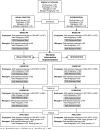The Effects of a Cluster Randomized Controlled Workplace Intervention on Sleep and Work-Family Conflict Outcomes in an Extended Care Setting
- PMID: 28239635
- PMCID: PMC5323265
- DOI: 10.1016/j.sleh.2016.09.002
The Effects of a Cluster Randomized Controlled Workplace Intervention on Sleep and Work-Family Conflict Outcomes in an Extended Care Setting
Abstract
Objectives: To evaluate the effects of a workplace-based intervention on actigraphic and self-reported sleep outcomes in an extended care setting.
Design: Cluster randomized trial.
Setting: Extended-care (nursing) facilities.
Participants: US employees and managers at nursing homes. Nursing homes were randomly selected to intervention or control settings.
Intervention: The Work, Family and Health Study developed an intervention aimed at reducing work-family conflict within a 4-month work-family organizational change process. Employees participated in interactive sessions with facilitated discussions, role-playing, and games designed to increase control over work processes and work time. Managers completed training in family-supportive supervision.
Measurements: Primary actigraphic outcomes included: total sleep duration, wake after sleep onset, nighttime sleep, variation in nighttime sleep, nap duration, and number of naps. Secondary survey outcomes included work-to-family conflict, sleep insufficiency, insomnia symptoms and sleep quality. Measures were obtained at baseline, 6-months and 12-months post-intervention.
Results: A total of 1,522 employees and 184 managers provided survey data at baseline. Managers and employees in the intervention arm showed no significant difference in sleep outcomes over time compared to control participants. Sleep outcomes were not moderated by work-to-family conflict or presence of children in the household for managers or employees. Age significantly moderated an intervention effect on nighttime sleep among employees (p=0.040), where younger employees benefited more from the intervention.
Conclusion: In the context of an extended-care nursing home workplace, the intervention did not significantly alter sleep outcomes in either managers or employees. Moderating effects of age were identified where younger employees' sleep outcomes benefited more from the intervention.
Figures



Similar articles
-
A workplace intervention improves sleep: results from the randomized controlled Work, Family, and Health Study.Sleep Health. 2015 Mar;1(1):55-65. doi: 10.1016/j.sleh.2014.11.003. Epub 2014 Dec 9. Sleep Health. 2015. PMID: 29073416 Free PMC article.
-
Age differences in workplace intervention effects on employees' nighttime and daytime sleep.Sleep Health. 2016 Dec;2(4):289-296. doi: 10.1016/j.sleh.2016.08.004. Sleep Health. 2016. PMID: 28105463 Free PMC article. Clinical Trial.
-
Work-Family Conflict and Employee Sleep: Evidence from IT Workers in the Work, Family and Health Study.Sleep. 2016 Oct 1;39(10):1871-1882. doi: 10.5665/sleep.6172. Sleep. 2016. PMID: 27568810 Free PMC article.
-
The nighttime nap strategies for improving night shift work in workplace.Ind Health. 2005 Jan;43(1):24-9. doi: 10.2486/indhealth.43.24. Ind Health. 2005. PMID: 15732300 Review.
-
Workplace interventions that support older employees' health and work ability - a scoping review.BMC Health Serv Res. 2020 May 26;20(1):472. doi: 10.1186/s12913-020-05323-1. BMC Health Serv Res. 2020. PMID: 32456635 Free PMC article.
Cited by
-
Individual and organizational interventions to promote staff health and well-being in residential long-term care: a systematic review of randomized controlled trials over the past 20 years.BMC Nurs. 2024 Mar 22;23(1):195. doi: 10.1186/s12912-024-01855-7. BMC Nurs. 2024. PMID: 38519896 Free PMC article.
-
Crossover of Resources and Well-Being within Employee-Partner Dyads: Through Increased Schedule Control.Community Work Fam. 2019;22(4):391-411. doi: 10.1080/13668803.2019.1616531. Epub 2019 Aug 16. Community Work Fam. 2019. PMID: 32982568 Free PMC article.
-
Unpaid Caregiving Roles and Sleep Among Women Working in Nursing Homes: A Longitudinal Study.Gerontologist. 2019 May 17;59(3):474-485. doi: 10.1093/geront/gnx185. Gerontologist. 2019. PMID: 29360993 Free PMC article.
-
Alleviating work-family conflict for female employees in Iran: The effect of a multimedia educational intervention.Curr Psychol. 2022 Apr 7:1-14. doi: 10.1007/s12144-022-03068-0. Online ahead of print. Curr Psychol. 2022. PMID: 35411130 Free PMC article.
-
Insomnia Interventions in the Workplace: A Systematic Review and Meta-Analysis.Int J Environ Res Public Health. 2020 Sep 2;17(17):6401. doi: 10.3390/ijerph17176401. Int J Environ Res Public Health. 2020. PMID: 32887475 Free PMC article.
References
Publication types
MeSH terms
Grants and funding
LinkOut - more resources
Full Text Sources
Other Literature Sources
Medical
Research Materials

